I have long been enchanted by Cecily Peele’s “MAP OF OXFORD’S HISTORY; WITH SOME OF HER WORTHIES”, (above) published in the 1930’s. A cursory glance at this funny, colourful pictorial depiction of the city is to do it an injustice, for you will be sure to discover something new with every fresh look. There in the line-up of dignitaries is Walter de Stapledon, Lord High Treasurer to King Edward 2 and founder of Exeter College, carrying his head, a reference to his decapitation by an angry mob armed with breadknives in October 1326. I love the hairy mammoth, whose bones were dug up near Longwall Street. You can almost hear him trumpet as he rampages out eastwards. And then there’s Mathew Arnold’s Scholar Gypsy, snoozing beside the river Thames with a walking staff and a book of poetry by his side. Harry Potter fans will also be thrilled to spot a man and his dog gathering the medicinal mandrake root which still grows at the Botanic Gardens as it has for over four centuries.
But even more exciting as I was staring intently at its vivid illustrations the other morning, I realise that this map was created just a stone’s throw from where I am writing today. The very Alley Workshops credited as the publishers at bottom right of Cecily’s drawing, are located with an arrow pointing to the building where they once traded. As the name suggests, it was down a narrow snicket linked to Blackfriars Hall just north of the Ashmolean Museum. 65a St Giles has long gone, swallowed up by the university as a centre for Classical and Byzantine research. But when Cecily and her friend Sally Ward founded the place in the early 1920s, it was making and selling much more than maps.
In the December 1922 issue of The Fritillary, a termly magazine published by the Oxford Women’s Colleges from the 1890’s until the 1930’s, Cecily and Sally advertise themselves as the place to go for Christmas shopping. Newly liberated women undergraduates, permitted at last in 1920 to collect their degrees, were the target customers.
“For Christmas gifts you’d better try,
The Alley Workshops in St Giles’;
They’ve heaps of things you’ll want to buy,
You’ll find no better place for mileses.”
By March 1923 they had become more specific in their marketing. Next to a posting for The Good Luck Tea rooms on Cornmarket promoting ‘hot breakfasts, dainty afternoon teas and river baskets’, The Alley Workshops lists a wonderful variety of items for sale – ‘wild and tame toys, jewels and beads, prints, pottery and handwoven scarves, dragons, jumpers and embroidered frocks, cigarette boxes and mirrors, knights, plaited felt slippers, prehistoric beasts.’ Evelyn Waugh apparently frequented the place, and I wonder if JRR Tolkien might have ventured in there too. Alley Workshop’s small hand-carved wooden figures of King Harold and William the Conqueror modelled on the Bayeux tapestry and literary figures from Alice in Wonderland and Chaucer, can still occasionally be found on auction websites.
‘Right down the Alley the blue door on the left’, they direct the satisfied customer in the June 1924 edition of The Fritillary. There they will find, ‘useful and beautiful things which you are invited to come and see. Although everything is for sale you will neither be asked nor expected to buy.’ What a wonderfully refreshing mantra. These days we’d be queueing around the block.
There’s not a huge amount known about Cecily Peele. Although she used the name Cecily, her actual name was Beatrice Cecilia. This is the name used on the 1939 register which shows that she was still living at 65 St Giles in 1939 with Ward – who is named confusingly as Dorothy not Sally, both doing ‘arts and crafts work’ while also serving as an air raid warden and an auxiliary for the Red Cross. Cecily uses her birth name initials – BCP – as a signature on the wonderful black and white prints in her ‘Encyclopaedia of British Bogies’, 24 creatures from folklore including Will O’ the Wisp, Herne the Hunter, the Phynnodderee (or Hairy One from the Isle of Man) and various Somerset and Dorset Pixies which are noted as ‘less malicious than Cornish Pixies’. Well worth a read. She also apparently used to lead a pet goat around on a leash.
The most comprehensive account I have discovered about her can be found here:
But in what I think would be in keeping with Cecily’s open thinking, I’d like to encourage – not demand – you to take a longer look at her Oxford map. And as way of encouragement I have devised a short quiz. It is not compulsory, but I hope you will find it fun.
Answers are supplied after the pictures.
- A flower depicted on the map has just become the emblem for the Oxfordshire Local History Association. What is it?
- One of the Colleges is misnamed on the map. Which one?
- Who was the Terrae Filius?
- Why does St Hilda’s College have an ammonite on its shield?
- Why does the mandrake gatherer have a dog with him?
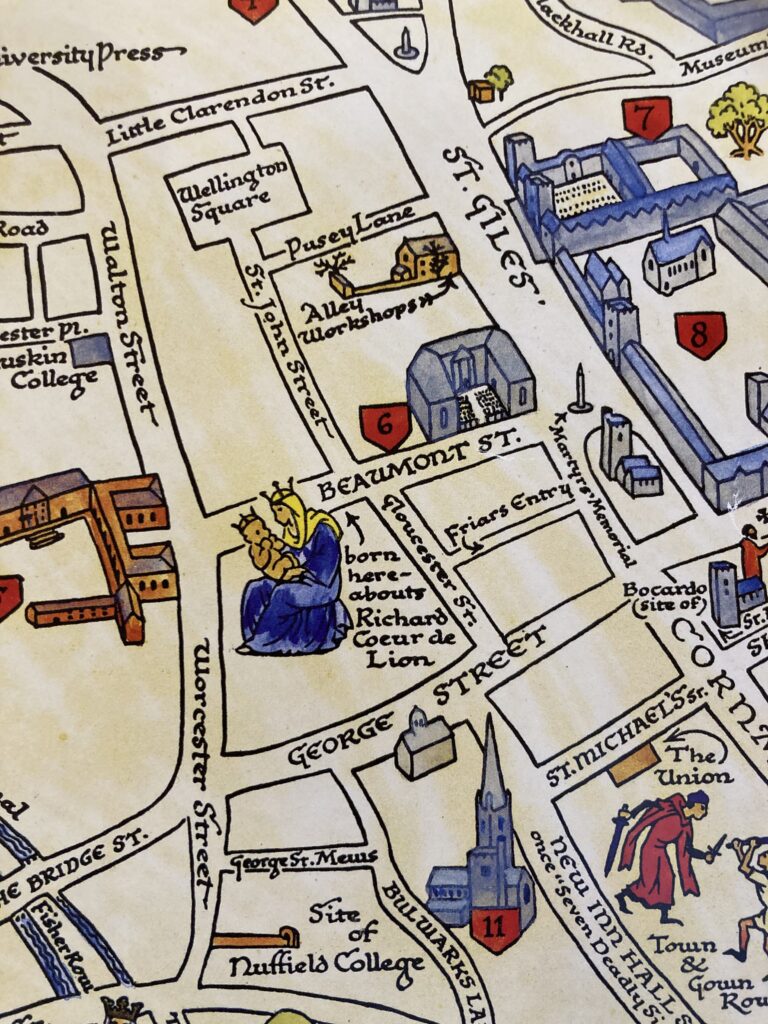
Alley Workshops – located just south of Pusey Lane on the map.
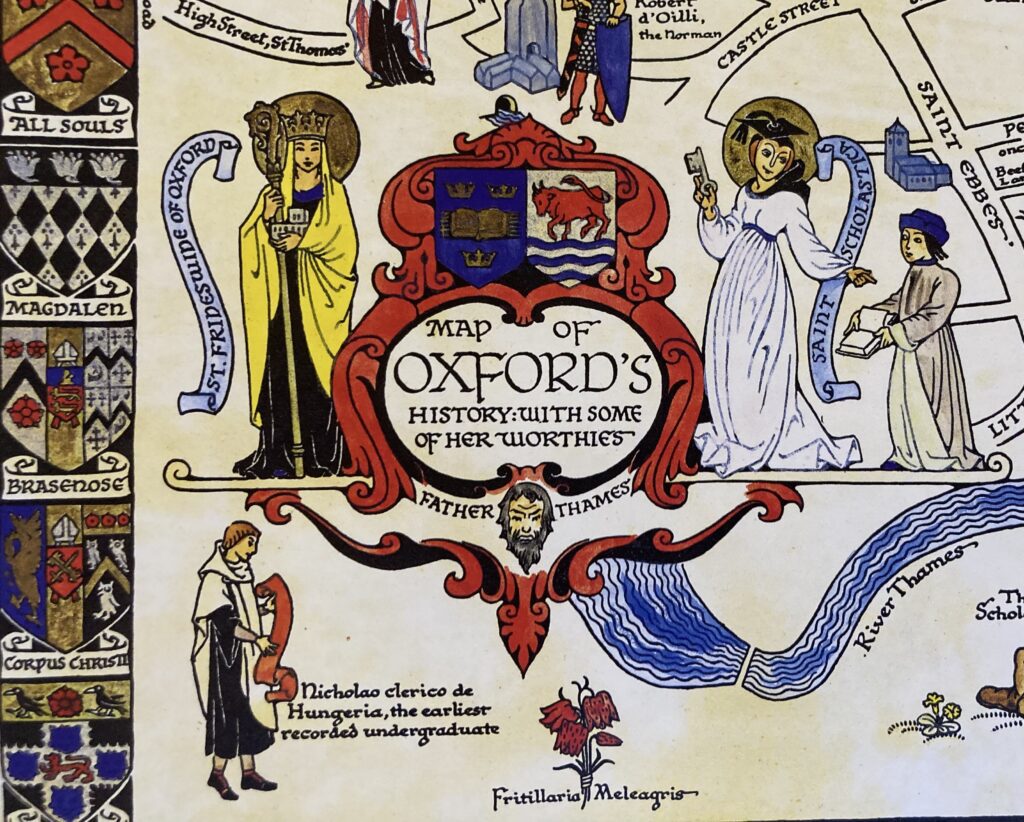
Two Oxford women, St Frideswide and St Scholastica are used as the poster girls for the city. Notice St Scholastica wearing her Mortar Board hat, a nod to the women’s newly won rights to collect their degrees in 1920.
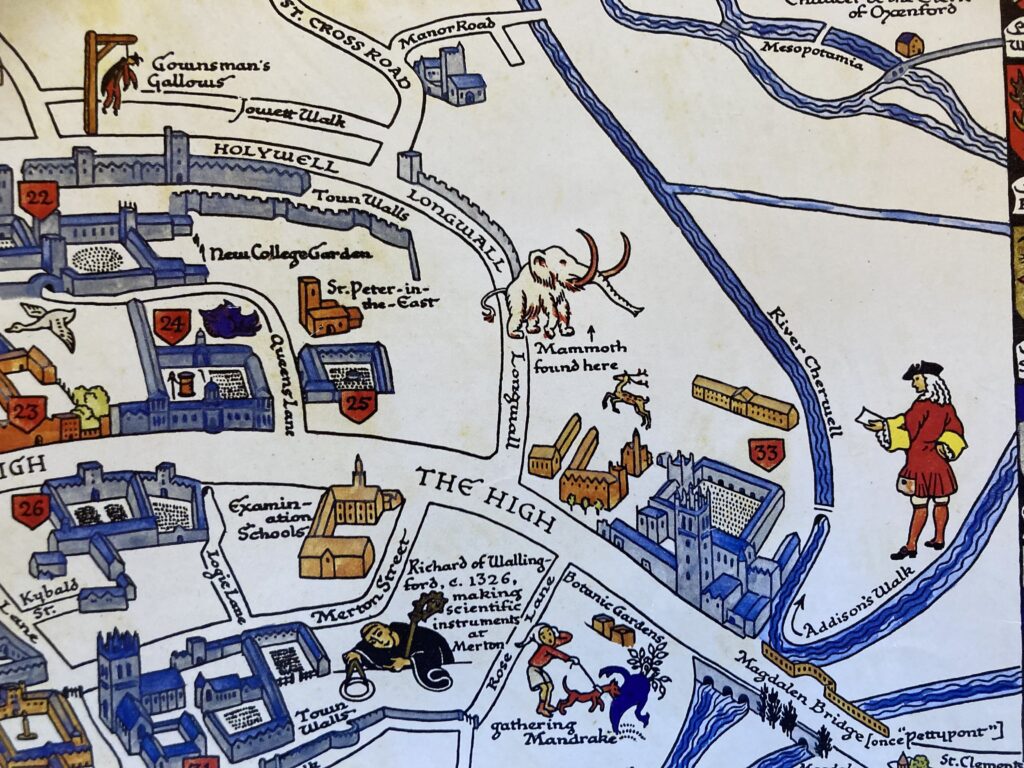
The hairy mammoth found in Longwall Street.
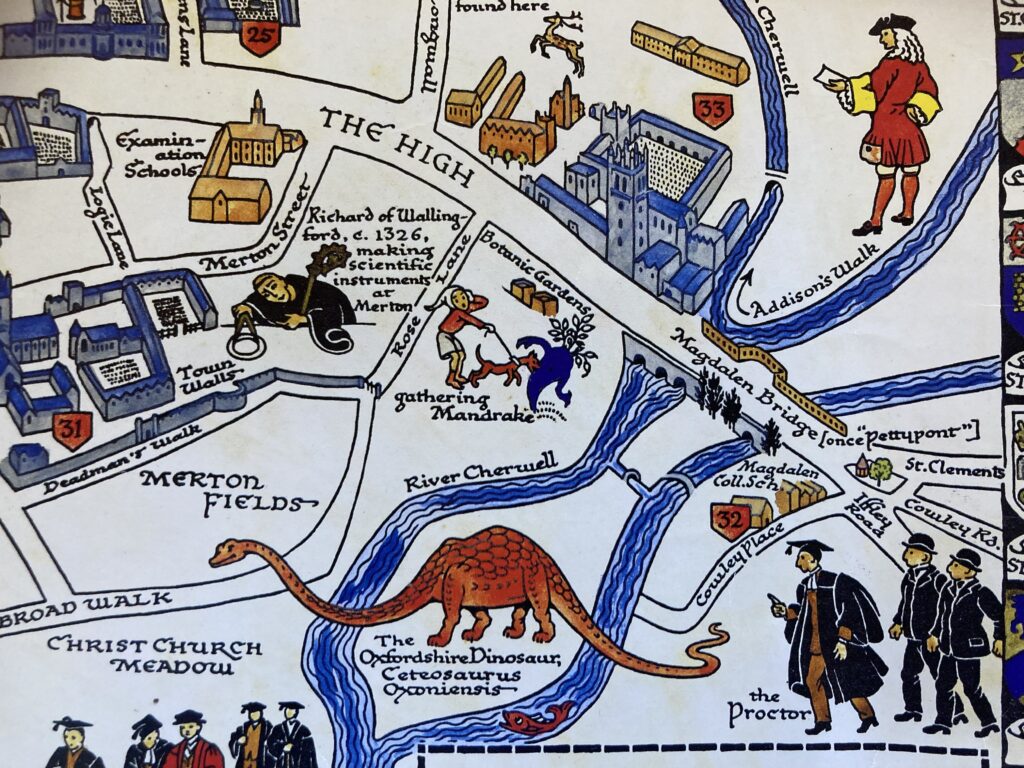
A man and his dog gathering Mandrake at Oxford’s Botanic Gardens.
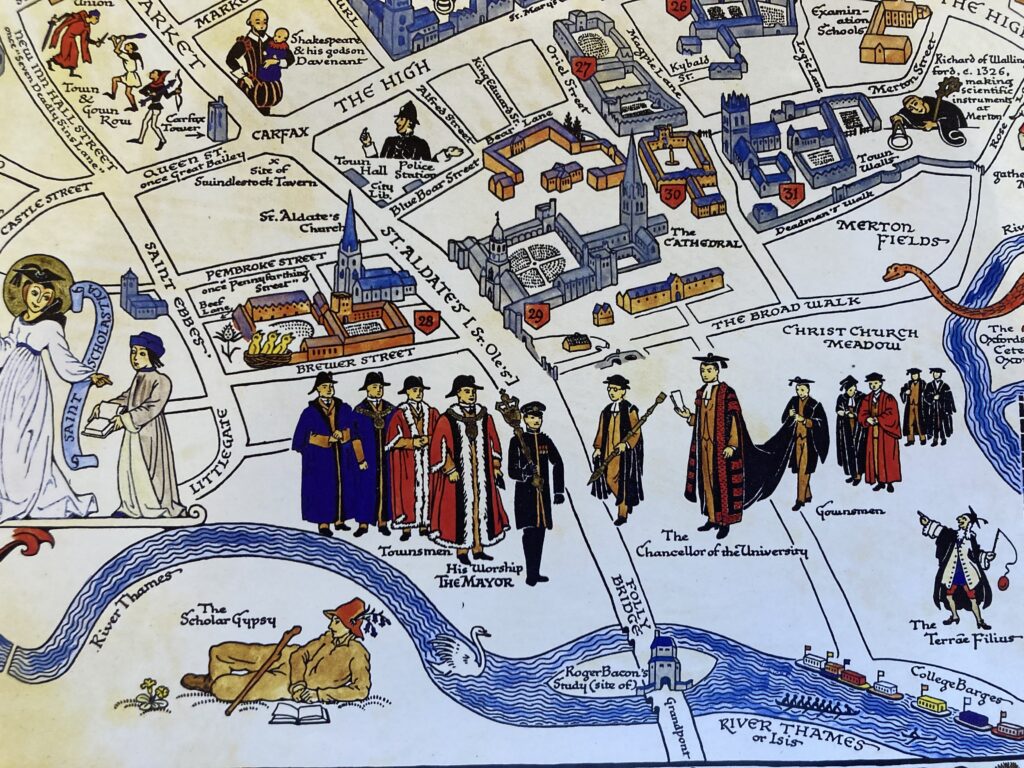
The ‘Terrae Filius’ (bottom right) poking fun at the University worthies.
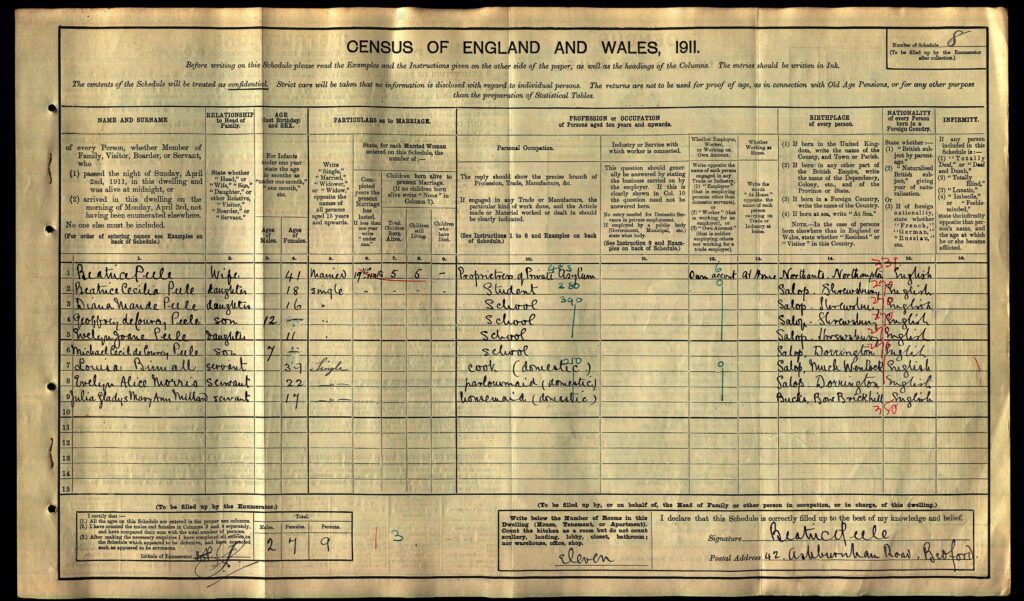
Cecily (registered as Beatrice Cecilia) was born in Shropshire. Her mother looked after what was then the local asylum. (Thanks to Stephanie Jenkins for supplying this)
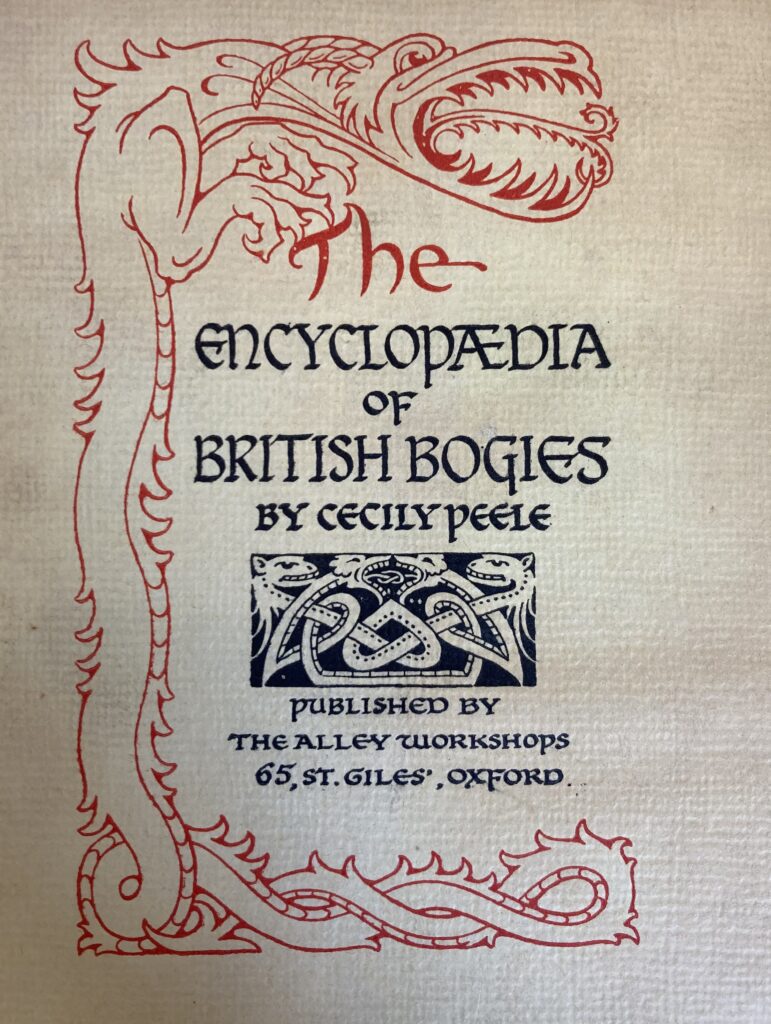
Cecily was a talented illustrator. This is the front cover to her ‘Encyclopaedia of British Bogies’.
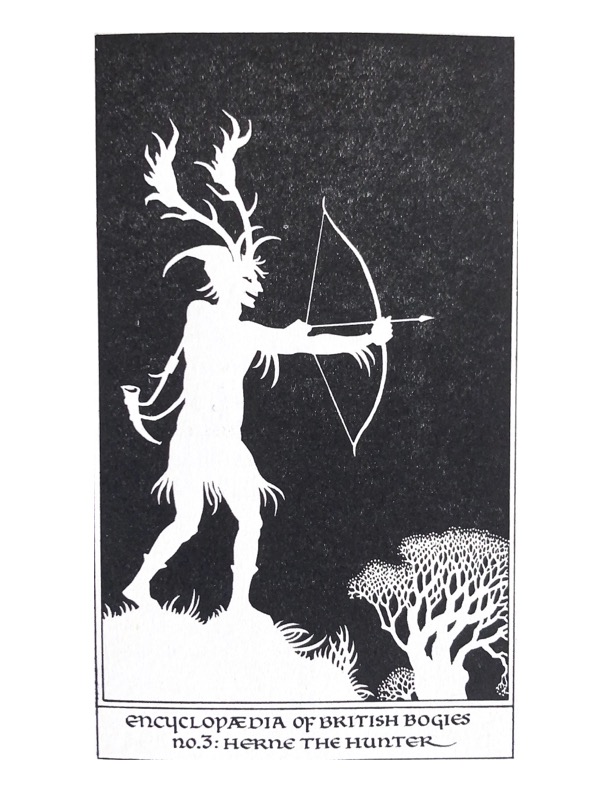
‘There is an old tale that goes Herne the Hunter,
Sometime a keeper here in Windsor Forest,
Does all the winter time at still midnight
Walk around an oak with great ragg’d horns.‘
Shakespeare: Merry Wives of Windsor
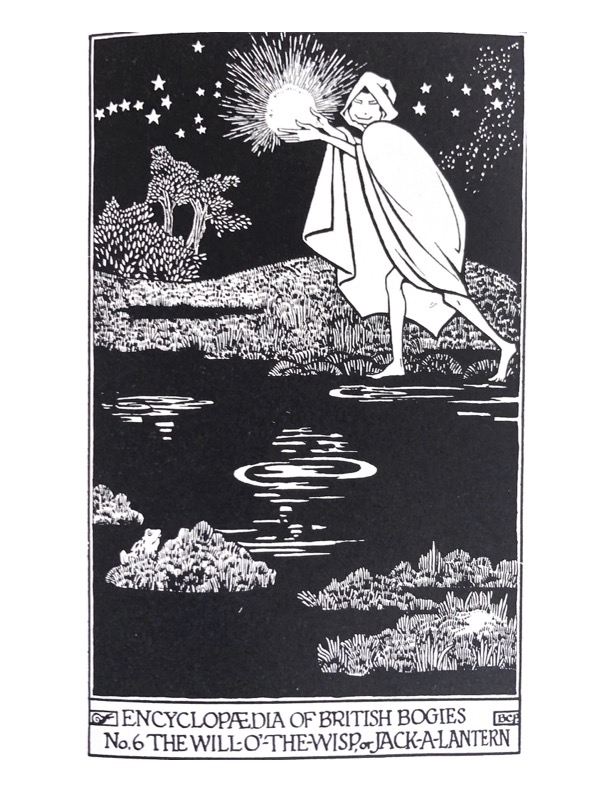
THE WILL O’ THE WISP OR JACK A LANTERN OR (in Worcestershire) HOBREDY’S LANTERN
“No Will o’ the Wisp mislight thee”
Herrick: ‘Night-piece to Julia’
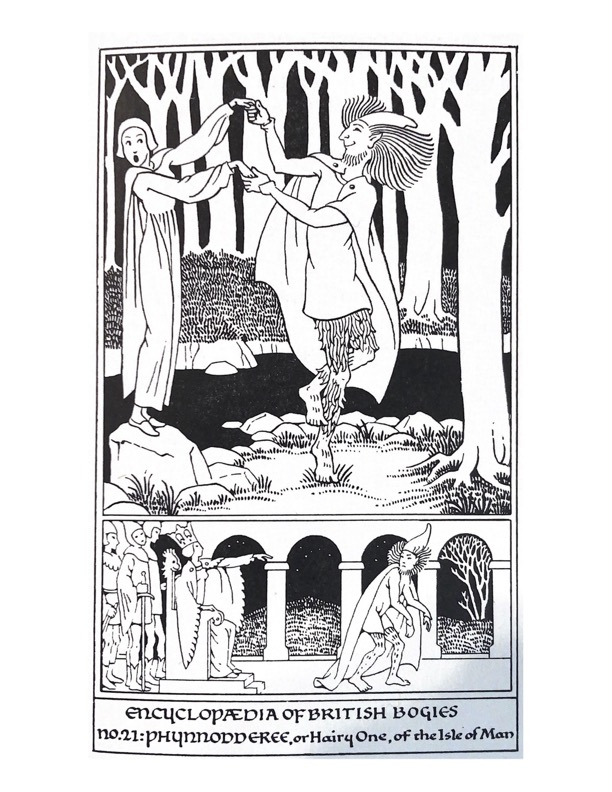
PHYNNODDEREE (OR HAIRY ONE on the Isle of Man)
Who was banished from the fairy court for dancing with a Manx maiden in the Glen of Rushen
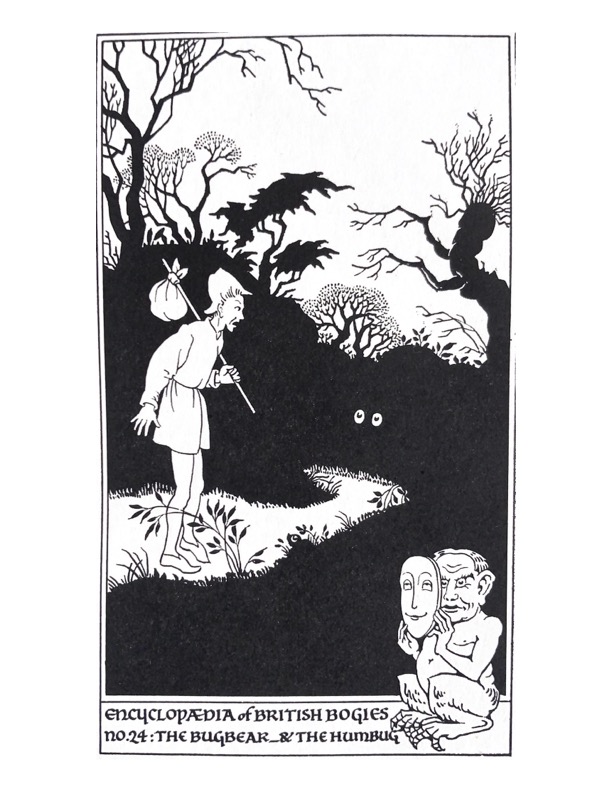
THE BUGBEAR OR BOGLE AND THE HUMBUG
Let us remember that the Bugbear or the Bogey in the dark should scare us less than that little or less well grown Humbug who sits at the back of each man’s mind.
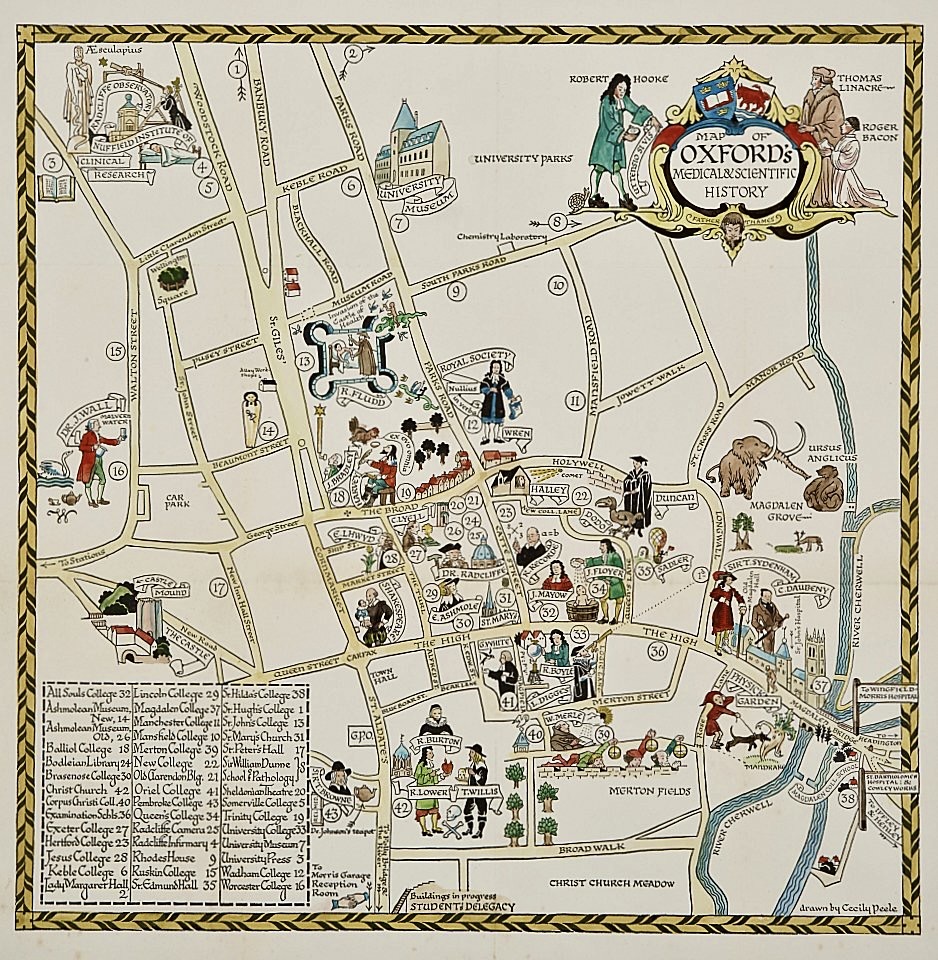
Cecily Peele’s other pictorial map – ‘MAP OF OXFORD’S MEDICAL AND SCIENTIFIC HISTORY’. It can be seen at the Oxford Museum of Science on Broad Street and also at Lord Nuffield’s house, Nuffield Place. I love Dr Johnson’s teapot, pictured with its owner at Pembroke College, which he attended for only 14 months. He was however very fond of the place, as well as drinking tea – a portrait of him and his teapot by Sir Joshua Reynolds hangs in the Senior Common Room.
ANSWERS TO QUIZ
- Frittillaria Meleagris – The Snakeshead Fritillary famously seen in Magdalen College Meadows in the spring.
- New College is labelled in the key as No 20 – The Bodleian Library.
- Literally ‘a son of the soil’ an orator who spoke at Oxford University’s ceremonial occasions, (now called Encaenia) first held in the Church of St Mary the Virgin. In those days it was a theatrical event, and it was the job of the ‘terrae filius’ to poke fun at those honoured by the University. Crowds would come to hear the often scandalous accusations and take part in the rowdy behaviour accompanying it. By the late 17th century, it was no longer felt appropriate to hold the ceremony in a church and so the Sheldonian was built and the whole thing became a much more sober affair.
- St Hilda, the 7th century Abbess of Whitby was supposed to have rid the area of snakes by turning them into stones. Ammonites are often called snakestones.
- In common mythology, and Harry Potter, when harvested the mandrake is supposed to emit a piercing and fatal shriek, killing the person who digs it up. The only safe way to do so is to cover your ears, and then tie a rope between the mandrake and a hungry dog. When the dog lunges for the scraps that are thrown out for it, the plant is uprooted causing the demise of the dog not the mandrake gatherer.
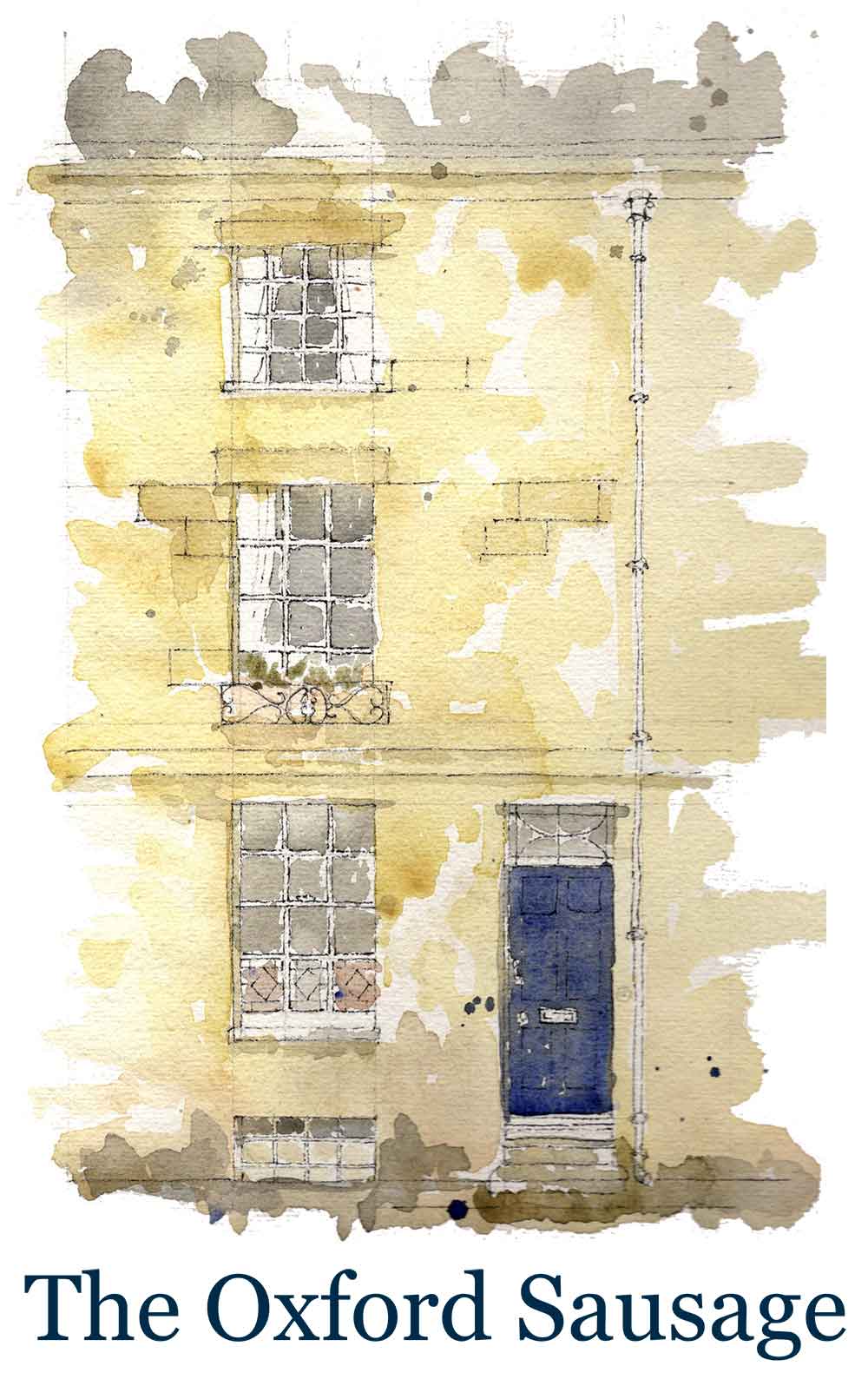
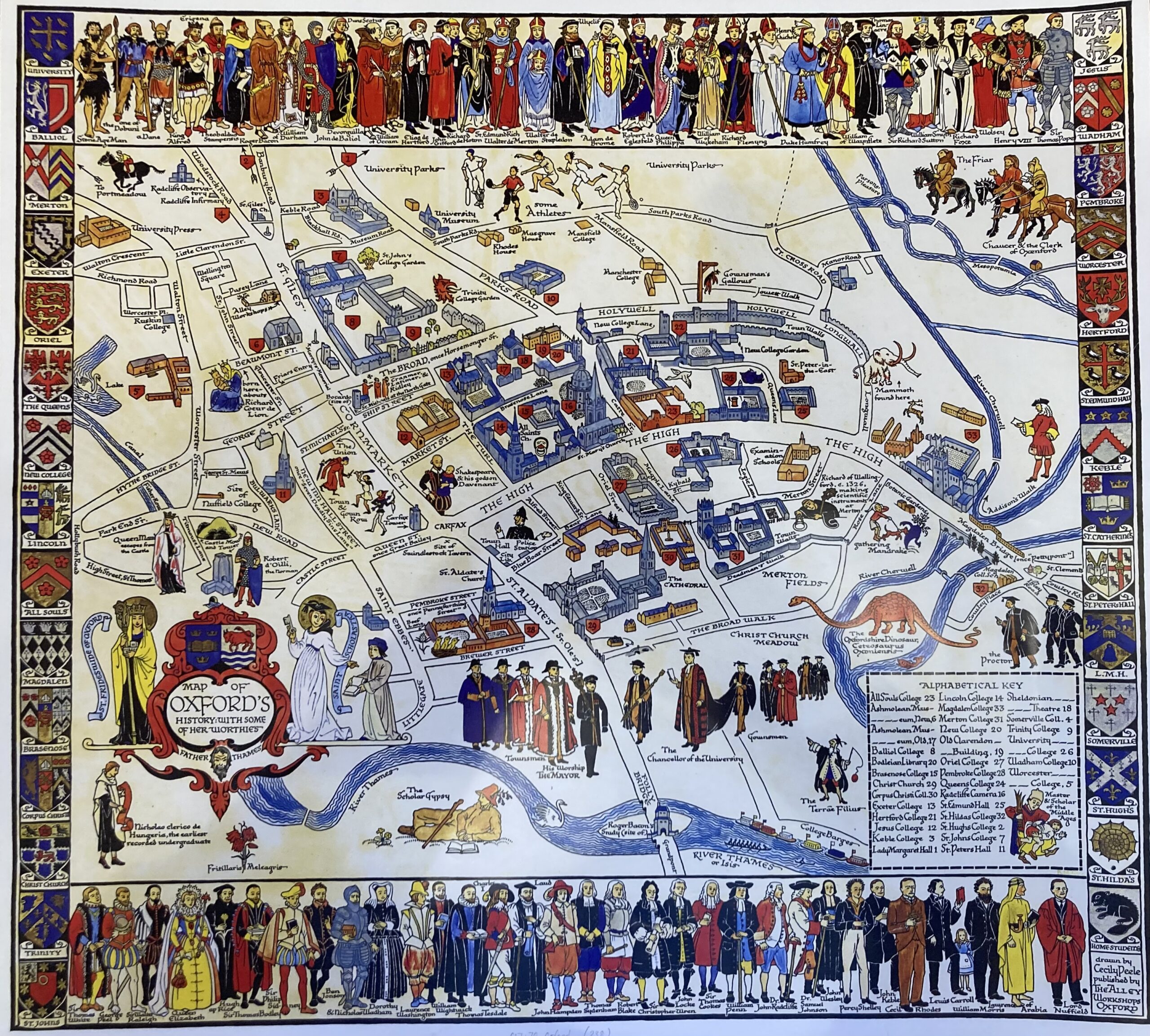
1 Comment
Join the discussion and tell us your opinion.
Wonderful piece. Wish those workshops still there… xx Gina